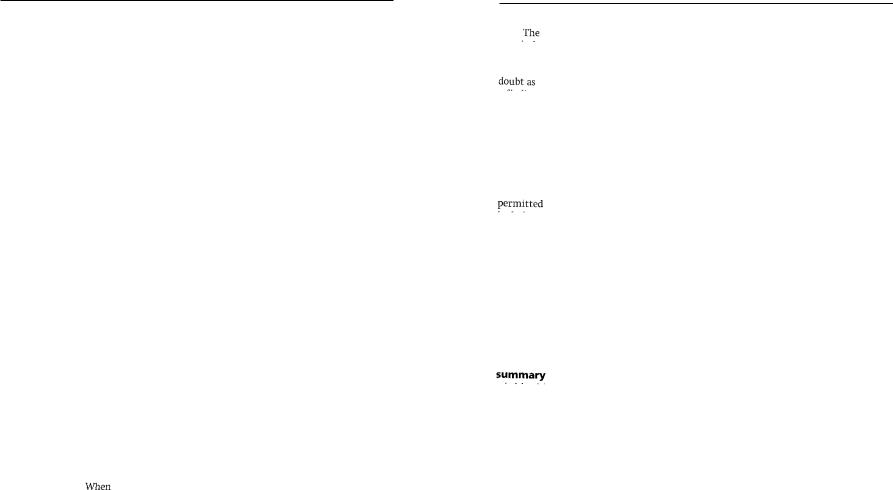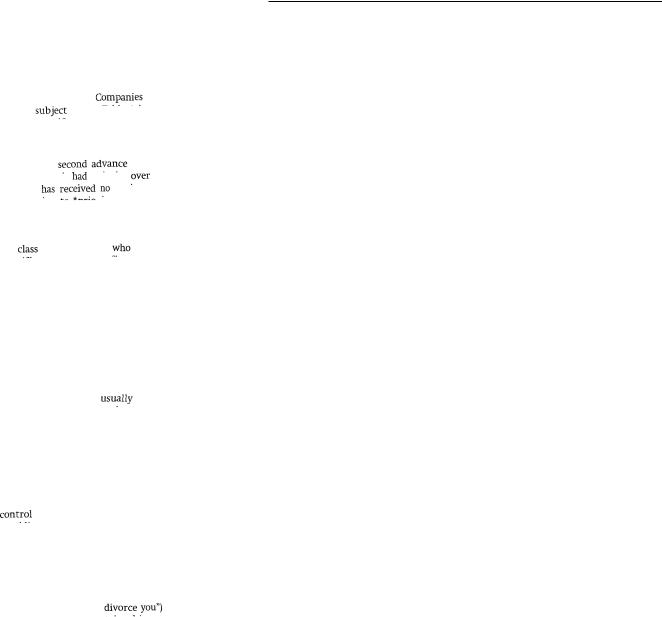
Elizabeth A Martin - Oxford Dictionary of Law, 5th Ed. (2003)
.pdf
specimen of breath |
472 |
In all other respects the law relating to blood specimens is the same as that relating to breath specimens.
specimen of breath A specimen of breath for analysis taken from a person suspected of *drunken driving. It is this specimen that usually forms the evidence for a prosecution and conviction for offences of drunken driving and should not be confused with the preliminary *breath test. The specimen may be required whenever the police are investigating any of these offences, but only if the suspect is at the police station. Usually he will have been brought to the station under arrest as a result of a positive breath test or refusal to undergo such a test. It is an offence not to provide a specimen without a reasonable excuse, and the police officer should warn a suspect of this when asking for the specimen. This offence is punishable by fine or imprisonment, endorsement (which carries 10 penalty points under the *totting-up system), and discretionary disqualification (in cases of being in charge
of a vehicle) or compulsory disqualification (in cases of driving or attempting to drive).
The suspect must give two breath specimens, which should be measured by means of an approved electronic device (not the *breathalyser used for the preliminary breath test) that automatically prints out the level of alcohol in the breath. A printout of the lower of the two readings is used as evidence in a subsequent trial, together with a signed certificate by a police officer that it refers to the defendant's specimen given at the stated time. The defendant must be given a copy of these documents at least seven days before his trial, and he may serve notice not later than three days before the trial that he requires the police officer who signed it to attend the hearing. At his trial, a defendant may bring evidence to show that he drank more alcohol between the time of the alleged offence and giving the specimen and that this accounted for his exceeding the prescribed limit. It is an offence, however, to deliberately drink more alcohol in order to make it difficult to prove his guilt.
Once a suspect has given a specimen he is free to leave the police station, but the police may detain him if they reasonably suspect that he is likely to continue driving with an excess alcohol level or while unfit to drive. Under certain circumstances the suspect can provide either a *specimen of blood or a *specimen of urine instead of a breath specimen. If the breath specimen records a reading of more than 35 but less than 50 micrograms of alcohol per 100 ml of breath (and prosecution is intended), the suspect is entitled to ask that it should be replaced by a blood or urine specimen.
specimen of urine A specimen of urine for analysis, used as an alternative to a *specimen of breath in cases involving *drunken driving. A specimen of urine may be required when there are objections to taking a breath specimen and when a medical practitioner thinks that a *specimen of blood should not be taken for medical reasons. A urine specimen must be provided within one hour after it has been asked for; two specimens are asked for, and it is the second specimen that is used as evidence in a subsequent trial. In all other respects the law relating to urine specimens is the same as the law relating to blood and breath specimens.
speeding n. Driving a motor vehicle at a speed in excess of that permitted. All vehicles adapted to carry more than seven passengers (apart from the driver) and all goods vehicles are restricted at all times to a maximum speed of 40 mph (unless they weigh less than 30 cwt unladen, in which case the maximum speed is 50 mph). Invalid carriages are restricted to 20 mph. Goods vehicles exceeding 3 tons unladen are restricted on motorways to 60 mph. Other vehicles are subject to speed limits
473 stakeholder pension
determined by the class of road, unless road signs specifically indicate otherwise (Le. 30 mph for restricted roads; 60 mph for single carriageways; 70 mph for dual carriageways and motorways).
The penalty for speeding is a fine, *endorsement (carrying 3 penalty points under the *totting-up system), and discretionary *disqualification. A person cannot be convicted of a speeding offence on the evidence of one witness alone, but the evidence of a single police officer reading his speedometer may be enough to secure a conviction. Speeding may itself be evidence of *careless and inconsiderate driving or *dangerous driving, but it is an offence in its own right even if it caused no danger and the driver was not in any way at fault. Speeding offences are subject to the requirement of a *notice of intended prosecution.
spent conviction A conviction that, after a specified number of years known as the rehabilitation period, may in all subsequent civil proceedings be treated as if it had never existed. The length of the rehabilitation period depends on the gravity of the offence, and some convictions are not subject to rehabilitation (e.g.when the sentence was life imprisonment). Dismissal from a job on the grounds of an undisclosed spent conviction may amount to *unfair dismissal. Similarly, to deny that one has been convicted if the conviction is spent does not amount to *perjury or *deception. Malicious publication of statements about a person's spent convictions can make the publisher liable for defamation, even if the statements are true. The provisions relating to spent convictions do not apply in criminal proceedings, but counsel and the court should, as far as possible, avoid referring to a spent conviction and references to it in open court may only be made with express leave of the judge in the interests of justice. A spent conviction in a record should
be marked as such. See also CRIMINAL RECORDS AGENCY.
spes successionis [Latin: hope of succeeding] See POSSIBILITY.
split order Formerly, an order for custody of a child made by divorce courts, granting legal custody to one parent and care and control to the other. It was made obsolete by the Children Act 1989.See 8 ORDERS.
split trial A trial in the *High Court (or, exceptionally, in the county courts) in which the issues of liability and amount of damages are tried separately.
springing use Formerly, a *use that arose on the occurrence of a future event. If property was given to X to the use of A when A married, A had a springing use that arose on his marriage.
spying (espionage) n. Obtaining or passing on to an enemy information that might prejudice the safety or interests of the state or be useful to an enemy. See
OFFICIAL SECRETS.
squatter n. A person unlawfully occupying land. See ADVERSE OCCUPATION; ADVERSE
POSSESSION; TRESPASS.
squatter'stitle See ADVERSE POSSESSION.
S1 Statement See WRIITEN STATEMENT OF TERMS OF EMPLOYMENT.
stag n. A speculator who applies for a new issue of securities in a public company with the intention of making a quick profit by reselling them if they increase in value within a few days of issue. This will only occur if the issue is oversubscribed, i.e. if there are more applicants for shares than there are shares available.
stakeholder pension A new type of low-cost pension, available from 6 April


statutory corporation |
478 |
statutory corporation |
See PUBLIC CORPORATION. |
statutory declaration |
A *declaration made in a prescribed form before a justice |
of the peace, notary public, or other person authorized to administer an oath. |
|
Statutory declarations are used in extrajudicial proceedings and not in court, but have similar effects to declarations made on oath.
statutory demand A standard form used for the enforcement of debts. It typically sets out a demand by a creditor to a debtor to honour payment of an amount owing. The amount may be due immediately or at a future date (if the creditor has reasonable grounds for believing that it will not be paid at this date). The demand will also specify a period of three weeks for repayment or other satisfactory solution. Failure to comply with the demand by the debtor will be evidence of an inability by the debtor to pay creditors and can be used to support a *compulsory winding-up petition.
Statutory Form of Conditions of Sale Standard terms of contract for the sale and purchase of land, published by the Lord Chancellor under the Law of Property Act 1925. They cover, for example, the vendor's obligations in proving his title to the land, the completion of the transaction, and the payment of interest by the purchaser if he fails to complete on the due date. The Statutory Form applies automatically to contracts made by correspondence subject to any express agreement between the parties, and any valid contract for the sale and purchase of land may be expressed to incorporate the Statutory Form.
statutory instrument Any *delegated legislation (not including subdelegated legislation) to which the Statutory Instruments Act 1946 applies. This includes (1) delegation made under powers conferred by an Act passed after 1947, either on the Crown or on a government minister, and expressed by that Act to be exercisable by Order in Council in the former case or by statutory instrument in the latter; or (2) delegation made after 1947 under powers conferred by an earlier Act and formerly governed by the Rules Publication Act 1893 (which was replaced by the 1946 Act and provided for the publication of delegated legislation to which it applied in an official series known as statutory rules and orders). Regulations or orders made before the 1946 Act came into force may still be statutory instruments if the power they exercise was a power to make statutory rules within the meaning of preexisting legislation, which was duly conferred on a rule-making authority under that legislation.
The 1946 Act relates in part to the publicity to be given to statutory instruments, requiring them to be numbered, printed, and published by the Queen's printer. They are numbered consecutively for each calendar year in the order in which the printer receives them; for example, the first statutory instrument to be received in 1993 would be cited as "S.1. 1993 No.1". Moreover, as a modification of the rule ignorantia juris non excusat (ignorance of the law is no excuse), the Act makes nonpublication a defence to proceedings for contravening a statutory instrument unless other adequate steps had been taken to bring it to the public notice. The Act is also concerned with certain aspects of parliamentary control. It standardizes negative resolution procedure for statutory instruments by providing that, if the enabling statute simply makes them subject to annulment by resolution of either House of Parliament, they are to be laid before Parliament for 40 days and liable to annulment during that period. It further provides that any statutory instrument required to be laid (either because of that rule or because the enabling statute expressly says so) must be laid before becoming operative unless there is good
479 |
statutory tenancy |
reason to the contrary (in which case, an explanation must be given to the Lord
Chancellor and the Speaker). See alsoJOINT COMMITTEE ON STATUTORY INSTRUMENTS.
statutory interpretation See INTERPRETATION OF STATUTES.
statutory lives in being See RULE AGAINST PERPETUITIES.
statutory maternity pay See MATERNITY RIGHTS.
statutory owner A person having the powers of an immediate beneficiary of *settled land, where the beneficiary himself is under 18 or there is no immediate beneficiary (for example, in a discretionary settlement in which no beneficiary has been appointed). The statutory owner is either the person of full age on whom the powers are conferred by the settlement; the trustees of the settlement (see SETTLED LAND ACT TRUSTEES); or, in a settlement made by will on a beneficiary under 18, the testator's personal representatives until a vesting instrument has been effected.
statutory periodic tenancy A *periodic tenancy that comes into operation on the expiration of an *assured tenancy for a *fixed term unless that tenancy is terminated by a court order or *surrender of the tenancy. The statutory periodic tenancy is on the same terms as the fixed term tenancy before it expired, except for the condition for terminating the tenancy at the end of the term. However, the landlord or tenant can apply to a *rent assessment committee to vary the terms of
the tenancy. See alsoASSURED SHORTHOLD TENANCY.
statutory rules and orders See STATUTORY INSTRUMENT.
statutory sick pay (SSP) Weekly payments by employers to employees unable to work because of sickness; it is payable, after the first three days of sickness, for a period of up to 28 weeks, after which employees can claim *incapacity benefit. Employees who do not qualify for SSPinclude those with fixed contracts of no more than three months and recipients of any social security benefits during the previous eight weeks. Formerly all employers were entitled to an 80% reimbursement for SSP by the government, and smaller companies were entitled to full reimbursement after the first six weeks of each SSPclaim. However, this position has been gradually altered since 1994. Currently in most cases no recoupment will be possible. The only exception is where an employer pays out, in any income-tax month, SSP exceeding 13% of his liability to pay national insurance contributions in that month. In such circumstances that excess can be recouped.
statutory tenancy A tenancy that comes into existence when the contractual element of a *protected tenancy is terminated and the former protected tenant continues to live in the property (a company cannot be a statutory tenant). A statutory tenancy continues only for as long as the tenant lives in the property (therefore it will end if the tenant attempts to sublet). When the tenant dies, however, the statutory tenancy can be transmitted to his spouse if she was living in the dwelling immediately before the tenant's death. If there is no spouse, the tenancy can be transferred to another member of the tenant's family who was living with him for the previous two years. This is known as a statutory tenancy by succession. The terms of a statutory tenancy are, in general, the same as those of the original contractual tenancy. If there is no provision for notice in the original tenancy, the tenant must give three months notice to terminate his tenancy. A landlord can terminate a statutory tenancy only by obtaining a court order for possession. Statutory tenancies are being phased out as no new protected tenancies can be created after the Housing Act 1988.See ASSURED TENANCY.






